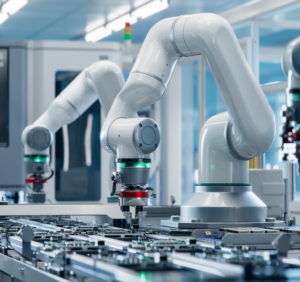Hyperautomation
End-to-end automation of all business processes

Hyperautomation - a brief definition
A brief definition
The term “hyperautomation” stands for a holistic concept of process automation. It describes a consistently applied automation strategy that encompasses the entire environment. This includes technologies for process analysis, modeling and management as well as traditional automation technologies such as RPA (Robotic Process Automation), IPaaS (Integration Platforms as a Service), LC/NC (Low-Code/No-Code) business applications and AI (Artificial Intelligence) in the form of ML (Machine Learning) and NLP (Natural Language Processing). Many companies are already using these technologies, but usually only in certain areas.
As companies strive to remain competitive in an era of increasingly complex global supply chains and business processes as well as an increasingly difficult labour market, they need to take a holistic view of their business-critical processes and optimize them. Hyperautomation therefore represents an important competitive advantage and ensures greater resilience. It enables companies to respond quickly and appropriately to unforeseen events such as crises, natural disasters, pandemics and strikes, and ensures that skilled workers are deployed in the right roles.


A step-by-step guide to Hyperautomation
Hyperautomation is not a one-off project. It is an iterative process that runs in a continuous optimization cycle. The various phases are repeated and influence the next iteration.
Process analysis
The start of every hyperautomation project is a critical assessment of the relevant business processes. Techniques such as process mining, task mining or traditional workshops are used to identify and analyze end-to-end processes. The aim is to identify optimization potential, regardless of whether parts of the relevant processes are already automated, for example with RPA, or are still completely manual.
Process optimization
Once the most important levers have been defined, the second step is to adapt them accordingly. Syntax uses BPMN 2.0 (Business Process Modeling and Notation) as the standard for modelling operating procedures and business processes and as a prerequisite for optimization measures.
Process automation
The theory is followed by practice. The measures developed in the second step are implemented, with end-to-end automation of the processes. An agile approach makes it possible to overcome any difficulties that arise directly.
Which tools are used for hyperautomation?
At Syntax, we rely on tools from SAP and Microsoft when it comes to hyperautomation. Firstly, because both IT ecosystems are already present in many companies. And secondly, because using solutions from established providers provides a solid basis for planning in an extremely volatile market that is gradually consolidating.
All technologies used follow an LC/NC (low-code/no-code) approach that maximizes the number of employees who can interact with them to achieve the goal of hyperautomation. The specialist departments should also be involved in the creation of digital solutions in order to promote a citizen developer culture. In this way, not only does the pooled expertise flow into the development process, but it also accelerates it and improves the quality of the results.
Process analysis
- SAP Signavio: SAP Signavio is a cloud-based suite of tools that includes numerous solutions for the analysis, modelling and optimization of business processes. With SAP Signavio, companies can examine their processes in detail, identify weaknesses and implement targeted improvements.
- Microsoft Power Automate Process Mining: Microsoft Power Automate Process Mining is a suite of tools that enables processes to be analyzed using both task mining and process mining. Based on the knowledge gained, process automation can then be tackled step by step.
Process automation
- SAP Process Automation: SAP Process Automation describes a range of solutions that enable users to automate repetitive processes. These solutions also include the use of AI components to increase the efficiency and accuracy of automation.
- Microsoft Power Automate: Microsoft Power Automate enables users to automate repetitive business processes either in the cloud (IPaaS) or at client level (RPA). Power Automate also provides users with AI tools, such as the AI Builder, to further improve and optimize automation.
Low-Code Excellence
- PowerApps and SAP Build Apps: With PowerApps and AppGyver, Citizen Developers can create apps that have user interfaces tailored to users‘ needs. These tools make it possible to develop customized applications without in-depth programming knowledge, which significantly improves efficiency and user experience.
- Copilot Studio and SAP Joule: Microsoft Copilot Studio and SAP Joule enable the creation of natural language processing (NLP) solutions to simplify processes. These tools help to develop interactive and intelligent chatbots that process user queries efficiently and support the automation of business processes.

Hyperautomation - an example scenario
A manufacturing company that already uses SAP wants to automate the maintenance of its production plant in order to achieve a hyper-automated end-to-end solution. Some of the individual processes are already partially digitized and connected to the ERP system either directly or via Excel, but not networked with each other.
If an operator discovers a maintenance requirement on the production line, they must first call the maintenance team. A maintenance employee then comes to inspect the problem. They must then return to their workstation to create the relevant order in SAP and manually order spare parts. Everyone involved must regularly log into SAP and check their inbox to verify the information and query the current order status.
With end-to-end process automation, the maintenance worker can use a handheld device to interact with the SAP system directly from the workshop. This allows them to analyze the maintenance data automatically generated by the predictive maintenance system on their handheld device, schedule the maintenance intervention, document their actions in real time, report costs and time spent and check the availability of spare parts directly. This hyper-automated system not only speeds up the process, but also makes it more efficient. It saves time and reduces costs.
Syntax - Your advisor for hyperautomation
Hyperautomation is not an end in itself; successful end-to-end automation is only as good as the underlying processes. In manufacturing in particular, this means that a good consultant not only knows how to use the IT solutions and technologies deployed, but also has a deep understanding of the industry-specific processes. Syntax has been advising manufacturing companies for many years as part of numerous successful projects. This makes us the ideal partner for medium-sized industrial companies. We know the market and the individual ecosystems and develop customized solutions for specific use cases together with our customers. Our expertise forms the basis for the automated optimization of business processes and the development of innovative business models.


Expert leadership in hyperautomation
“Hyperautomation – It is our vision of a holistic approach to automating business processes. From understanding business processes to improving them. We focus on the most important thing: people. We make it possible to realize our full potential by taking the robot out of the human.“
Sinan Ioannidis
Director, Process Automation Excellence
E-Mail
+49 162 415 9100